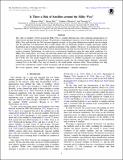Is There a Disk of Satellites around the Milky Way?
Author(s)
Maji, Moupiya; Zhu, Qirong; Marinacci, Federico; Li, Yuexing
DownloadMaji_2017_ApJ_843_62.pdf (524.8Kb)
PUBLISHER_POLICY
Publisher Policy
Article is made available in accordance with the publisher's policy and may be subject to US copyright law. Please refer to the publisher's site for terms of use.
Terms of use
Metadata
Show full item recordAbstract
The "disk of satellites" (DoS) around the Milky Way is a highly debated topic with conflicting interpretations of observations and their theoretical models. We perform a comprehensive analysis of all of the dwarfs detected in the Milky Way and find that the DoS structure depends strongly on the plane identification method and the sample size. In particular, we demonstrate that a small sample size can artificially produce a highly anisotropic spatial distribution and a strong clustering of the angular momentum of the satellites. Moreover, we calculate the evolution of the 11 classical satellites with proper motion measurements and find that the thin DoS in which they currently reside is transient. Furthermore, we analyze two cosmological simulations using the same initial conditions of a Milky-Way-sized galaxy, an N-body run with dark matter only, and a hydrodynamic one with both baryonic and dark matter, and find that the hydrodynamic simulation produces a more anisotropic distribution of satellites than the N-body one. Our results suggest that an anisotropic distribution of satellites in galaxies can originate from baryonic processes in the hierarchical structure formation model, but the claimed highly flattened, coherently rotating DoS of the Milky Way may be biased by the small-number selection effect. These findings may help resolve the contradictory claims of DoS in galaxies and the discrepancy among numerical simulations.
Date issued
2017-07Department
Massachusetts Institute of Technology. Department of Physics; MIT Kavli Institute for Astrophysics and Space ResearchJournal
Astrophysical Journal
Publisher
IOP Publishing
Citation
Maji, Moupiya et al. “Is There a Disk of Satellites Around the Milky Way?” The Astrophysical Journal 843, 1 (July 2017): 62 © 2017 The American Astronomical Society
Version: Final published version
ISSN
1538-4357
0004-637X